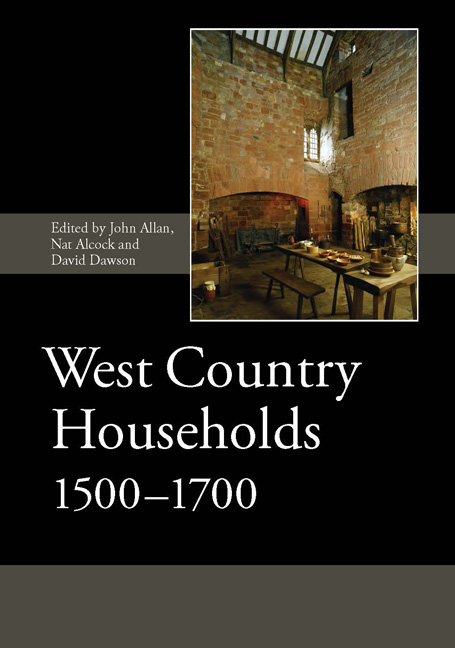Book contents
- Frontmatter
- Dedication
- Contents
- List of Illustrations
- List of Contributors
- List of Abbreviations
- Introduction
- I The Form and Development of West Country Houses
- II The Decoration of West Country Houses
- III The Material Culture of West Country Households
- 10 Culinary Artefacts in West Country Households, 1550–1700: Form, Function and Nomenclature
- 11 The Archaeology of the West Country Bronze Foundries
- 12 Cast Bronze Cooking Pots in England, 1500–1720
- 13 Table Glass in the West Country Home, c. 1500–1700
- 14 Portuguese Faience in South-West England
- 15 Dinner on the Ceiling: the 17th-Century Plasterwork at 144 Fore Street, Exeter
- 16 Pots and Texts: Understanding Pots in Use
- 17 Presenting an Elizabethan Interior: the Reinterpretation of St Nicholas Priory, Exeter
- Index of People and Places
- Index of Subjects
17 - Presenting an Elizabethan Interior: the Reinterpretation of St Nicholas Priory, Exeter
from III - The Material Culture of West Country Households
Published online by Cambridge University Press: 05 May 2015
- Frontmatter
- Dedication
- Contents
- List of Illustrations
- List of Contributors
- List of Abbreviations
- Introduction
- I The Form and Development of West Country Houses
- II The Decoration of West Country Houses
- III The Material Culture of West Country Households
- 10 Culinary Artefacts in West Country Households, 1550–1700: Form, Function and Nomenclature
- 11 The Archaeology of the West Country Bronze Foundries
- 12 Cast Bronze Cooking Pots in England, 1500–1720
- 13 Table Glass in the West Country Home, c. 1500–1700
- 14 Portuguese Faience in South-West England
- 15 Dinner on the Ceiling: the 17th-Century Plasterwork at 144 Fore Street, Exeter
- 16 Pots and Texts: Understanding Pots in Use
- 17 Presenting an Elizabethan Interior: the Reinterpretation of St Nicholas Priory, Exeter
- Index of People and Places
- Index of Subjects
Summary
St Nicholas Priory, Exeter, retains important evidence of an elaborate Elizabethan interior, created within the ranges of a medieval priory. The scheme is attributable to the Hurst family, leading members of the city's merchant community, and is datable to the last quarter of the 16th century. This paper describes the archaeological and documentary study carried out to understand the surviving evidence, and the use of a range of sources, including local inventories and objects excavated in the city, alongside the building itself, to offer to the public a reconstruction of a fully furnished and fully equipped Elizabethan household.
INTRODUCTION
This paper offers a case study in the interpretation and presentation of a series of rooms in a wealthy urban household in a south-west English city. It arises from an educational project undertaken at St Nicholas Priory, Exeter, by the Royal Albert Memorial Museum (RAMM), supported by the national government initiative Renaissance and by the Heritage Lottery Fund. Like many monuments of this sort, the priory was previously presented as a bare structure, sparsely furnished with a selection of the museum's collection. The aim of the project was to use all available sources of evidence – close examination of the fabric, local archaeological finds, documentary evidence, research into furniture history and food history, and wider studies of the operation of the Elizabethan house – to reconstruct these rooms as furnished and functioning spaces of c. 1600. The approach followed a style of display developed in other British houses of this period, for example by the Shakespeare Birthplace Trust at Shakespeare's Birthplace in Stratford-upon-Avon, by Cadw at Plas Mawr, Conwy, and perhaps most famously in the working kitchens of the 1540s in Hampton Court Palace. We wished to represent the household using site-specific detail and local evidence wherever possible: to recreate Exeter rooms rather than generalized English ones. We also sought to highlight the personal stories of the family identified from documentary study, another feature of the interpretation at Plas Mawr.
- Type
- Chapter
- Information
- West Country Households, 1500–1700 , pp. 401 - 418Publisher: Boydell & BrewerPrint publication year: 2015



